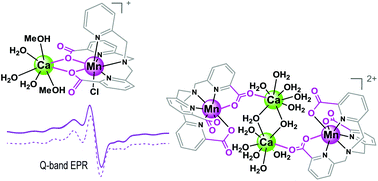Calcium and heterometallic manganese–calcium complexes supported by tripodal pyridine-carboxylate ligands: structural, EPR and theoretical investigations†
Abstract
Carboxylate-bridged Mn(II)–Ca(II) complexes are potentially relevant for mimicking the first stages of the Oxygen-Evolving Complex (OEC) assembly process. Here, we report on new homonuclear Ca(II) and heteronuclear Mn(II)–Ca(II) complexes with carboxylate-functionalized tripodal tris(2-pyridylmethyl)amine ligands, the heptadentate H3tpaa, previously reported, and the new hexadentate H2tpada, containing respectively three and two carboxylate units. The mononuclear [Ca(Htpaa)(OH2)] (Ca1) and dinuclear [Ca(tpada)(OH2)2]2 (Ca2) calcium complexes, as well as the tetranuclear [{Mn(tpaa)}2{Ca(OH2)5(μ-OH2)}2][Mn(tpaa)]2 (Mn2Ca2·2Mn) and dinuclear [Mn(tpada)ClCa(OH2)2.67(MeOH)2.33]Cl (MnCa) heterometallic species have been structurally characterized; the syntheses of Ca1 and Mn2Ca2·2Mn being previously reported by us (Inorg. Chem., 2015, 54, 1283). The Mn(II) and Ca(II) are linked by two μ1,1-bridging carboxylates in MnCa, while only one μ1,3-carboxylate bridge connects each Ca2+ ion to each Mn(II) in Mn2Ca2. A variable number of water molecules (n = 1 to 7) are coordinated to Ca in all complexes, most of them being involved in hydrogen-bond networks, in analogy to what occurs in the photosystem II. All donor atoms of the tpaa3− and tpada2− ligands are coordinated to the Mn2+ ions, despite the unusually long distance between the Mn2+ ion and the tertiary amine imposed by the constraining nature of the ligands, as supported by theoretical calculations. Solid state EPR spectroscopy, in combination with DFT calculations, has also shown that the Ca2+ ion has an effect on the electronic parameters (zero field splitting) of the linked Mn(II) in the case of MnCa (μ1,1-carboxylate bridges). In Mn2Ca2 (μ1,3-carboxylate bridge) the Ca2+ ion induces only slight structural changes in the Mn coordination sphere.


 Please wait while we load your content...
Please wait while we load your content...